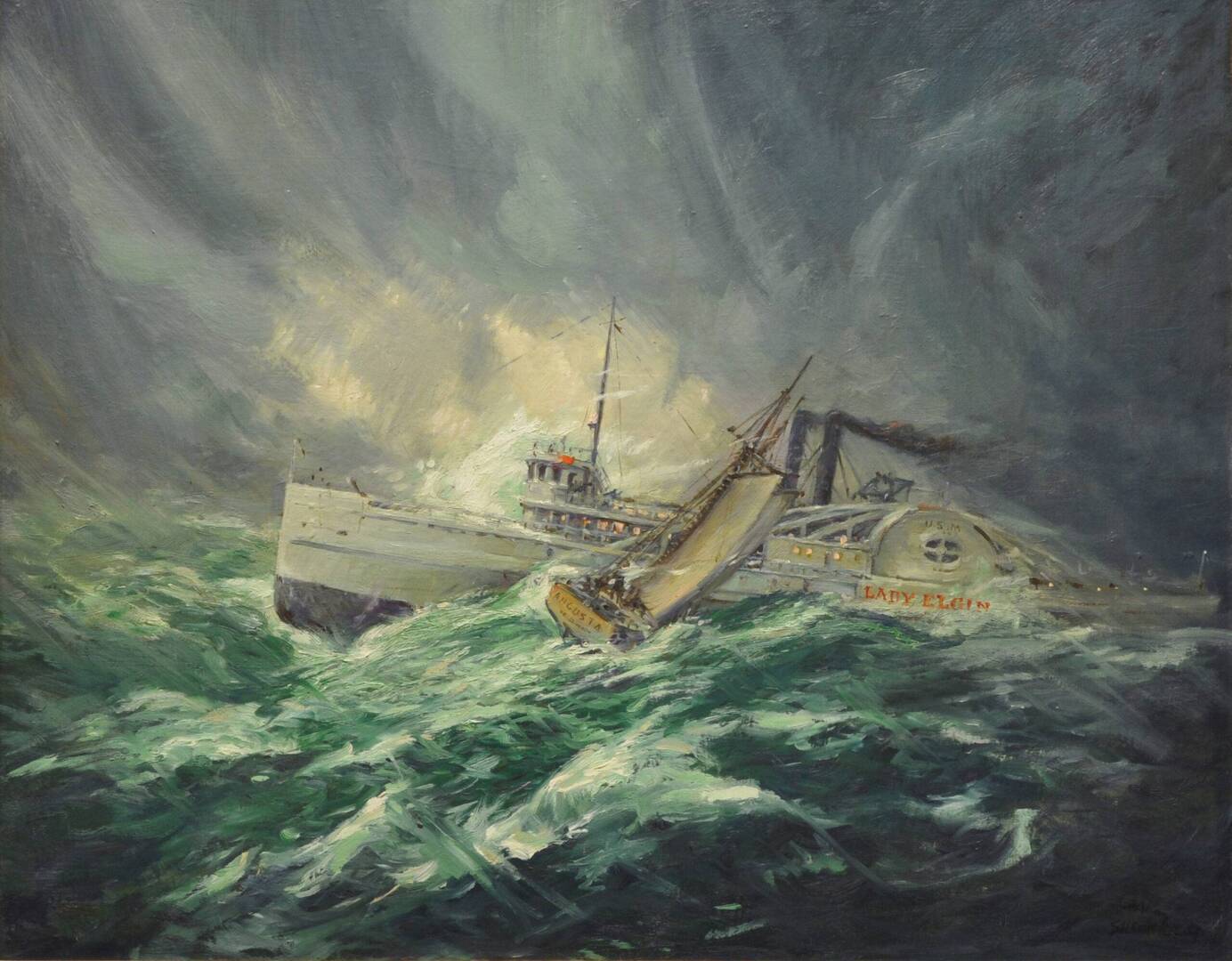WHS and the Lady Elgin
Categories: Gazette
Gazette Column by Helen Weaver
Appeared in the Gazette: Fall 2010

We’ve all heard of “six degrees of separation” but how about three degrees of connection? Hanging over the fireplace in the Evanich Room at 411 Linden is a painting with links to two our our past exhibits Palette of Our Past: Artists in Winnetka and Serving On All Fronts:Winnetka and World War II that depicts a third event being commemorated fall 2010, the sinking of the Lady Elgin.
The Lady Elgin Disaster was painted by artist Joseph “Gary” Sheahan who was born in Winnetka in 1893 and lived on Cherry Street with his father James W. Sheahan, a U.S. Customs official, his mother Mary Gary Sheahan, and seven brothers and sisters. As a young man Sheahan worked as a construction worker on the Sanitary Canal, and as a “student lineman” for the old Chicago telephone company before studying at both the University of Notre Dame and the Art Institute of Chicago. Prior to beginning his professional career, he spent several years proving up a homestead claim in Minnesota. Sheahan joined the staff of the Chicago Tribune in 1922, and in 1943 at age 50, signed up to serve 13 months in the European theater and 8 months in the Pacific as an artist correspondent. He created at least 1,000 portraits of Chicago-area GIs and 150 paintings of battle scenes, all of which were printed in the Tribune. Many of Gary Sheahan’s works are now maintained in the art collection at the U.S. Army Center of Military History in Washington, DC.
Sheahan’s artwork was shown at the Gallery in Tribune Tower both before and after his retirement from the Tribune in 1958. In reference to an exhibit in 1955, one reviewer commented, “Mr. Sheahan has been noted for years for his powerful illustrations. He brings his characters startlingly to life and imbues them with sentiment or adventure as the situation demands…Sheahan is a magnificent illustrator and a much more than competent painter. His show is one of the most satisfying of the season.” As an artist and a Winnetkan, Sheahan fits right in alongside the artists featured in our Palette of Our Past exhibit.
However, Sheahan is remembered primarily for capturing the sights and feelings of scenes both big and small during World War II. The first painting Sheahan sent back from Europe depicted the landings at Omaha Beach on D-Day in June 1944. The painting was shipped by bomber plane with the reproduction appearing in the Tribune less than three weeks after the event. Sheahan’s description of the illustration was printed by the Tribune: “A plane is coming close. It is diving and the sound of the motors takes on a higher pitch. There is the whistle of the bomb; then a terrific explosion. The ship next to us is hit. Soon the hoses are going and the fire is under control.”
Sheahan’s own favorites include scenes of the Marine advance on the airfield at Cape Gloucester at Christmas in 1943 and a “little picture of Bastogne, Belgium on the day it was relieved by the Nazis.” In addition to the battle scenes, Sheahan sent back sketches of hundreds of servicemen and women that were printed regularly in the Tribune. In 1945, after his return from the war, Sheahan received a citation from the 4th armored division for his “stories and sketches about the division and its men (that) helped maintain its superb fighting spirit.”
The painting of the Lady Elgin has been in the Society’s collection for many years, though it is unclear how it was acquired. It depicts the moment of impact between the schooner Augusta and the unfortunate sidewheel steamer during the predawn hours of September 8, 1860. It seems fitting that one of Gary Sheahan’s dramatic scenes of chaos will be present during our exhibit on World War II as a reminder of the many scenes from the war that he so vividly recorded with his inks, oils and watercolors.

No comments yet.